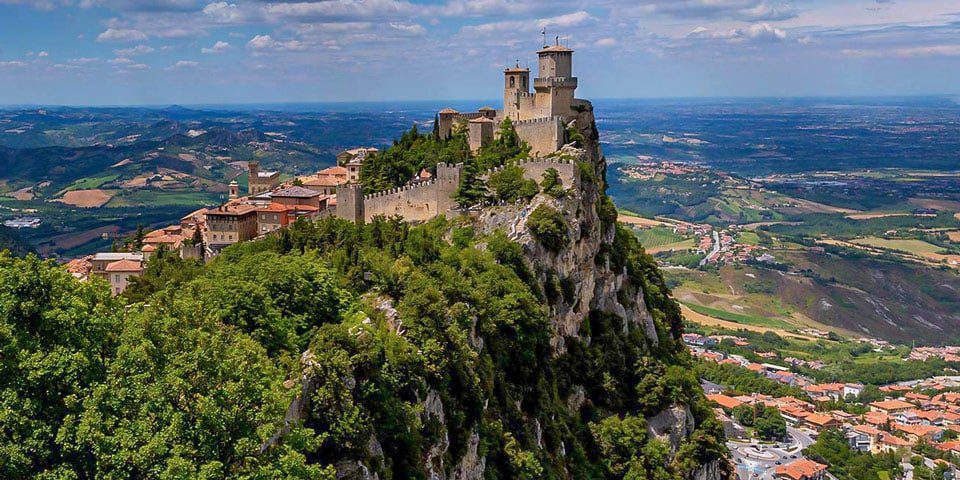The history of one of the smallest states, San Marino, spans more than seventeen hundred years. It is located on Mount Titano and has been attracting thousands of tourists for many years due to its abundance of architectural monuments, historical landmarks, and shops with affordable prices. Regarding the latter, this republic is indeed part of a free trade zone, so the abundance of shops and shoppers positively impacts the country’s economy. You can reach it from the nearest Italian city, Rimini. The 25-kilometer journey can be made by bus or by renting a car. The borders are weakly guarded, so you can cross them without being noticed. Here are some of the most interesting sights in San Marino.
History
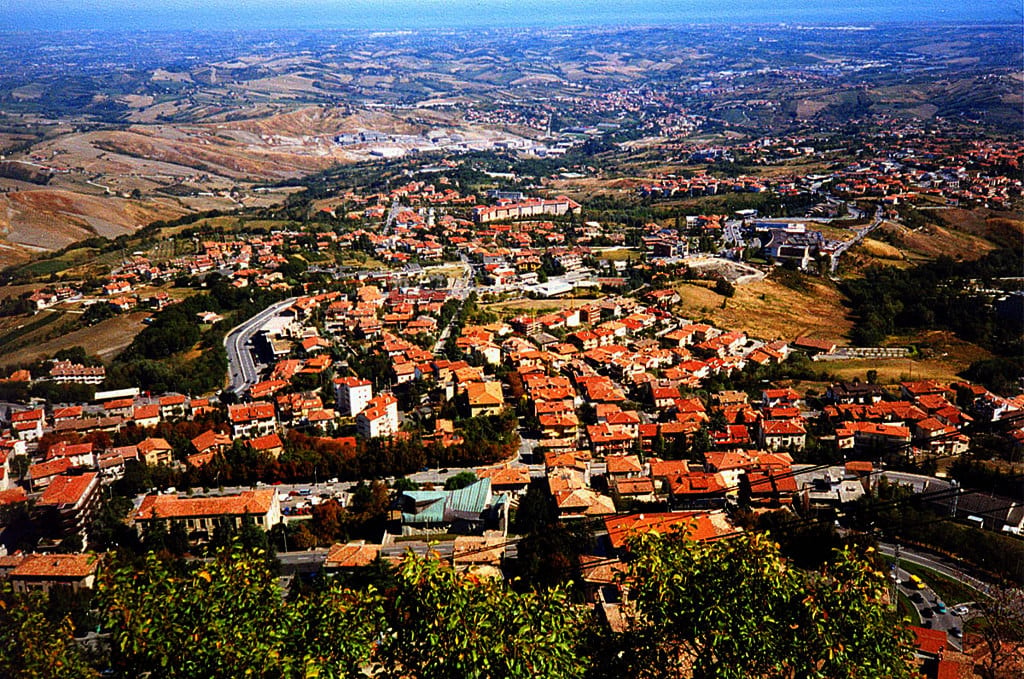
There is a legend that in 301 AD, a model Christian named Marino, hiding from pagans, found refuge on Mount Titano. Due to his wisdom and justice, he gained fame as a Holy Man, and other representatives of his faith began to come to him. Many stayed to live here, and soon formed a Christian community, electing Marino as a deacon, which was approved by the Bishop of Rimini. The lands were owned by Donna Felicissima, who sympathized with these people and gave them the rock. However, the founding moment of the free and proud republic of San Marino is considered to be 855 AD, when it received official status as an independent state.
Constant numerous raids led to the construction of fortress walls. The republic’s residents defended themselves not only against military detachments but also against the Italian church led by the Pope. However, in 1461, an attack by the ruling family of Rimini, the Malatesta, ended these disagreements. The rulers of San Marino signed an agreement to form an alliance with the great Roman church, which helped them win the war against the invaders and annex their territories. This was the only and last territorial change of the republic’s borders.
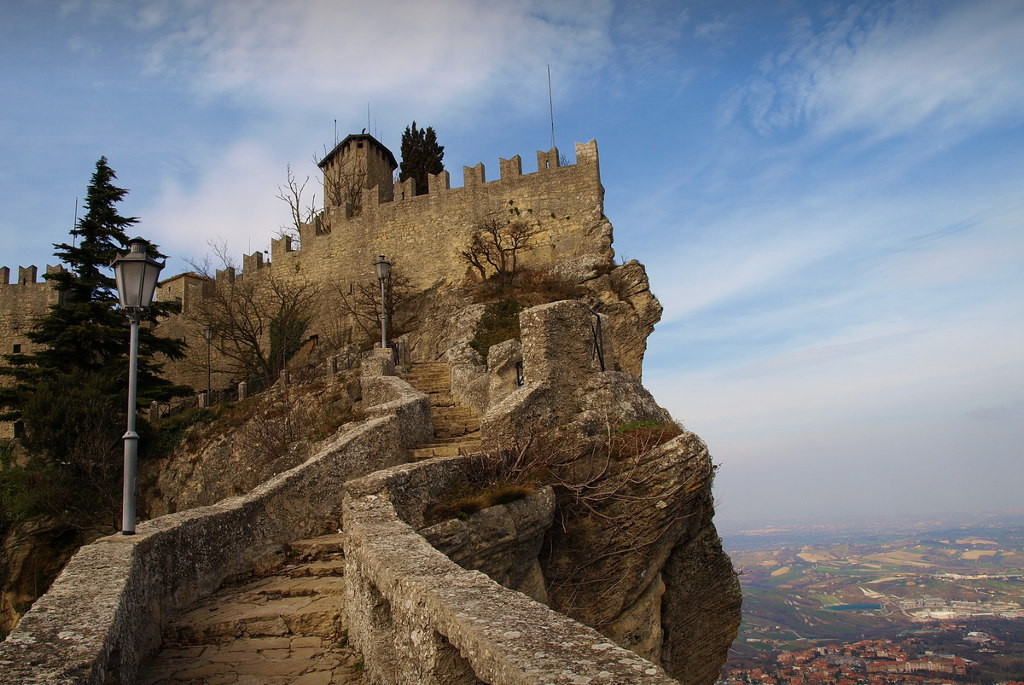
Since then, all attempts to conquer this free people and seize their lands have failed. The residents also supported Italy’s independence, fighting as volunteers during the war of 1915-1918. During World War II, the state maintained neutrality and provided refuge to refugees from the neighboring country. Interestingly, San Marino’s defensive walls, which withstood numerous enemy attacks, were mostly damaged by the country’s own residents, who began dismantling them to build their homes. Fortunately, wise rulers realized in time that tourism could become a major source of income for their state and banned the destruction of historical monuments.
However, by that time, most of the fortification walls had already been dismantled. Currently, you can see only a fragment of the first belt, representing a wall connecting a tower called Torrione and two gates, San Francesco and della Rupe. The second belt section, passing between the Fratta tower and the Cava Antica parking lot, as well as the wall between the Montale and Fratta fortresses, which were previously part of the third belt, have been restored.
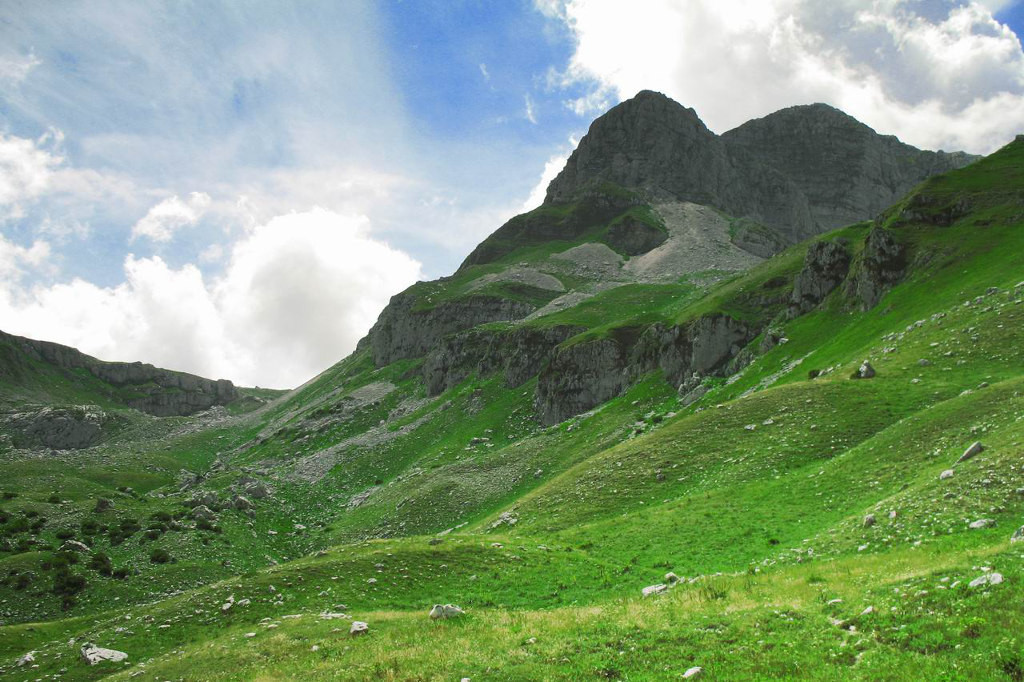
The entire state’s territory is divided into nine areas, but tourists are advised to start their tour from the city of San Marino, considered the main historical center and capital of the republic. In terms of the number of attractions, San Marino probably ranks first in the world. You can book a three-hour city tour for $50. During this time, you can see the three Towers of Liberty, connected by galleries, from which you can see not only the Po Valley and the Apennine Mountains but even Venice. The cost includes visits to the weapon museum and the Ferrari museum. The rest of the time, you can stroll through the capital’s small streets accompanied by a guide who tells the history of this region. Your acquaintance with San Marino’s attractions begins with the first steps, that is, from the gates of San Francesco, which bear an inscription warning travelers against carrying weapons.
Towers of San Marino
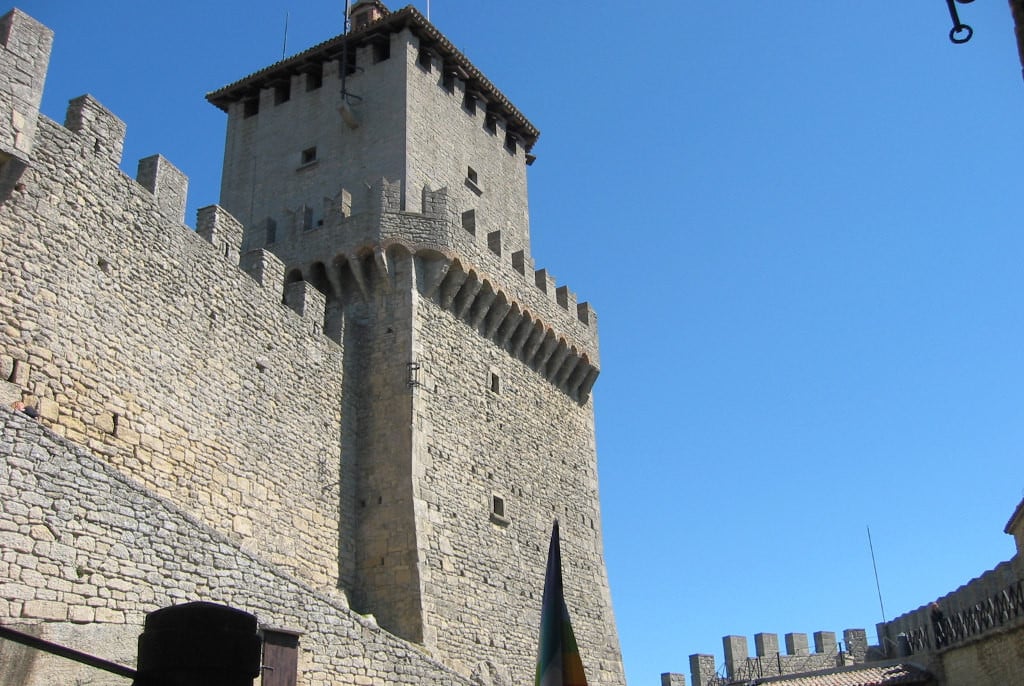
The main historical landmarks of the capital are the city fortress towers. These include:
- Guaita
- La Cesta
- Montale
The oldest is Guaita, built in the sixth century, serving as an observation post. This structure is located on a rock, so it has no foundation. As other fortresses were built, its functional purpose changed, and Guaita became a local prison. Now it houses the Guard Museum and the Artillery Museum.
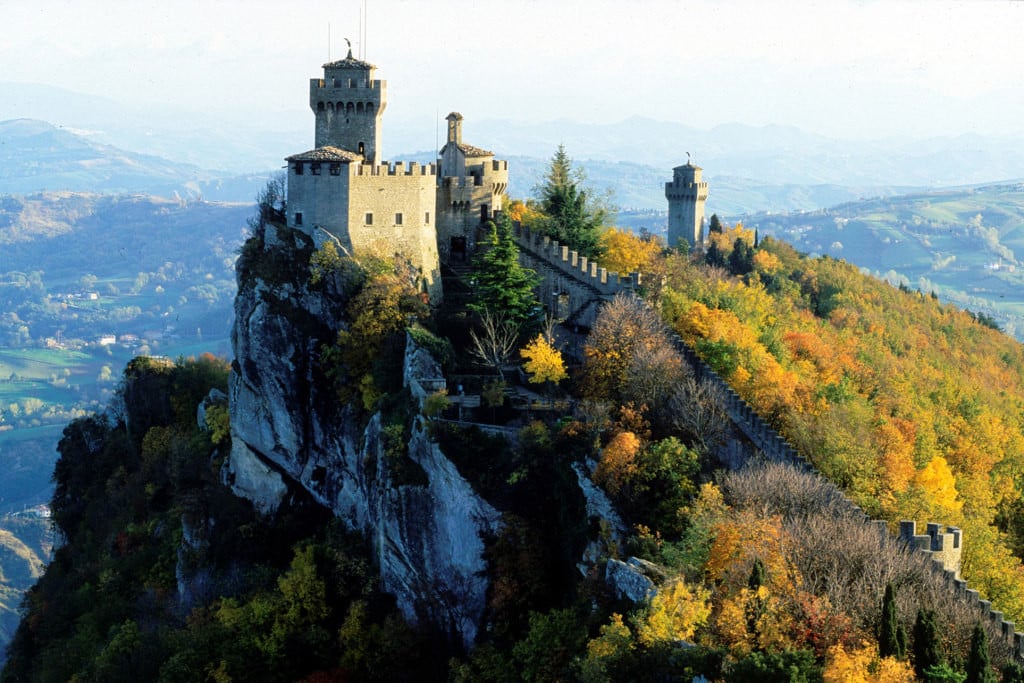
The next tower, Cesta, appeared in the fourteenth century and also served as an excellent defense for observers. It was restored in 1956 and is now used as a weapon museum, which houses more than seven hundred specimens. Montale, the next tower, was built in the fourteenth century. Currently, entrance to it is prohibited.
Basilica of San Marino

Built at the beginning of the 19th century on the site of an ancient church. Decorated with masterpieces of painting and sculpture, the basilica traces its history back to the 4th century. The construction of the new temple lasted 12 years under the guidance of an invited architect from Bologna. The main altar, under which the relics of Saint Marino, the founder of the state, rest, is crowned by his marble statue, and Corinthian columns give the basilica’s hall a special solemnity.
The temple is built in the neoclassical style and consists of three naves with seven altars located in their semicircles. All state and religious ceremonies take place here. The country’s main temple serves as a venue for concerts and performances, notably hosting the annual Autumn Music Festival. Address: Domus-Plebis Square near Palazzo Pubblico. Services are held on weekends from 11 am.
Gallery of Modern Art

Located in the medieval city, among fortress walls and towers on the mountainside, the contemporary art museum houses a collection of modern times. The collection of new art has been housed in the San Marino gallery since 1956. The first exhibition was marked by the appearance of Italian master Renato Guttuso and an exhibition of 500 artistic works. Since then, the gallery has exhibited works of Italian and foreign art of the 20th century and fresh works in various artistic directions, divided into sections. Here are halls of photography, watercolor and oil painting, graphics, and sculpture.
The works of young contemporary masters of painting and photography are displayed in the former Church of Saint Anne, where annual exhibitions are held. The hall of contemporary photography is famous for world-renowned names and works of unrecognized amateur geniuses. The gallery attracts both curious visitors and connoisseurs of contemporary creativity.
Address: Via Eugippio. Opening hours: January to June: 9 am to 5 pm, June to mid-September: 8 am to 8 pm, September 14 to January: 9 am to 5 pm. Admission fee: 3 euros.
State Museum of San Marino
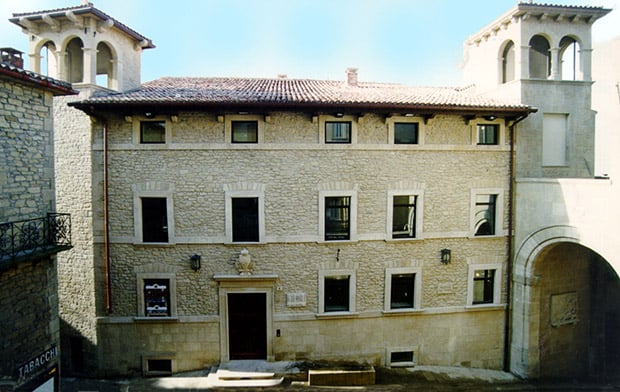
Five thousand historical, archaeological, and artistic exhibits are housed in this museum on the four floors of the building, which opened on donations from citizens in the late 19th century. The museum gained autonomy in 1982 when it was moved to its current building in Palazzo on the country’s main square. The rich collection of archaeological finds covers the period from the Neolithic to the Middle Ages. Here you can see donations from ancient civilizations: Etruscans, Egyptians, Romans, among which household items and jewelry are of the greatest interest. The numismatics department introduces ancient medals and coins, and the art section is famous for works by sculptor Stefano Galletti, 17th-century painters Pompeo Batoni and Elisabetta Sirani, and icons.
Address: Piazza Titano, Pergami-Bellucci Palace. Opening hours: January to June from 9 am to 5 pm, June 8 — September 13 from 8 am to 8 pm, September 14 to January from 9 am to 5 pm. Admission fee: 3 euros.
Monte Titano in San Marino
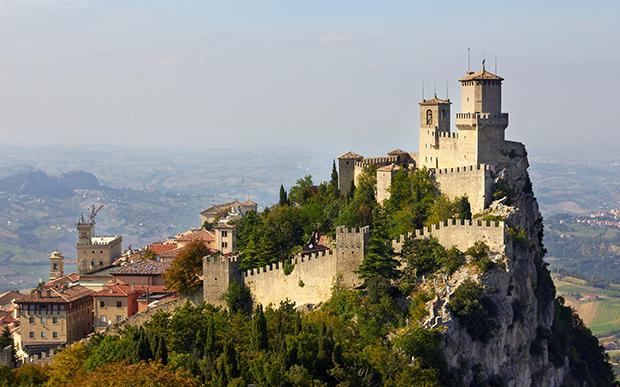
The limestone mountain where the founder and Saint Marino found refuge is the most striking landmark of the oldest European state. It has three peaks, on which three majestic fortress towers rise: Prima Torre (Guaita), Cesta, and Montale, forming the historical center of the city. The most representative and ancient of them, Guaita, appeared here in the 11th century. The main tower is an impregnable bastion. It hangs over a dizzying cliff and is fortified with two rows of walls.
The stone castle was the refuge of the first inhabitants of San Marino. For a long period in history, its walls housed a prison. Here are stored weapons donated by Italian kings, which are loaded with blank charges, announcing national celebrations. Today, the tower is a popular tourist attraction, offering stunning panoramic views of the city and surroundings. It still looks formidable. The fortress houses a small collection of paintings dedicated to contemporary society’s problems.
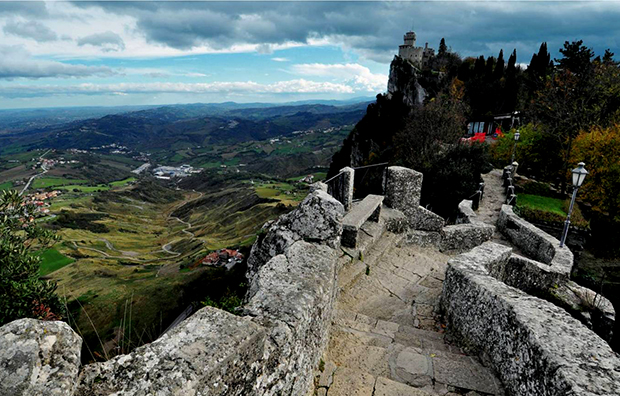
Cesta was built somewhat later and dates back to the first half of the 13th century. The second tower underwent multiple restorations. The castle stands on the highest point of Monte Titano and is famous for its collection of cold and firearms, numbering 500 specimens. Every year, San Marino hosts a Medieval Festival, allowing residents to travel back in time. The third fortress, Montale, also dates back to the 13th century, like the second. The watchtower has a pentagonal shape and offers excellent observation opportunities of the surroundings, but entry is restricted. You can only admire the fortress from the outside. All three towers are connected by a network of roads among winding hills.
Museum of Torture Instruments in San Marino
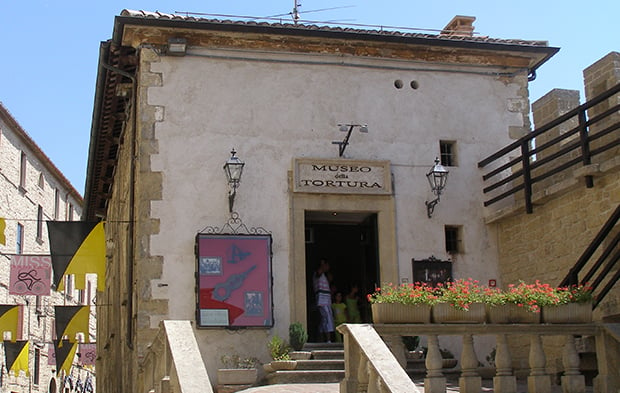
The museum showcases the methods of struggle and instruments used by medieval inquisitors against dissenters. Seeing the terrifying collection of 100 items, it is impossible to imagine that violence was “a common thing” in the Middle Ages. The Iron Maiden, the spiked chair, steel “cat’s claws,” knee-crushers, and the Spanish boot are a partial list of tools used for executing people, torturing, and causing unbearable pain.
Among the exhibits, a significant portion consists of devices for women, punished by male inquisitors for any offense. Each exhibit has a plaque with a detailed description of the instrument’s use or a photograph illustrating its function. The items are reconstructed from images and descriptions from the 19th-20th centuries, with some preserved from the 15th-16th centuries. The museum regularly holds thematic exhibitions narrating the inquisition’s activities in different regions.
Address: Porta San Francesco. Admission fee: adults — 8 euros, children from 4 to 10 years old — 6 euros. Opening hours: January-February from 10 am to 6 pm, March-December from 10 am to 7 pm, August from 10 am to 8 pm.
Maranello Rosso Collection
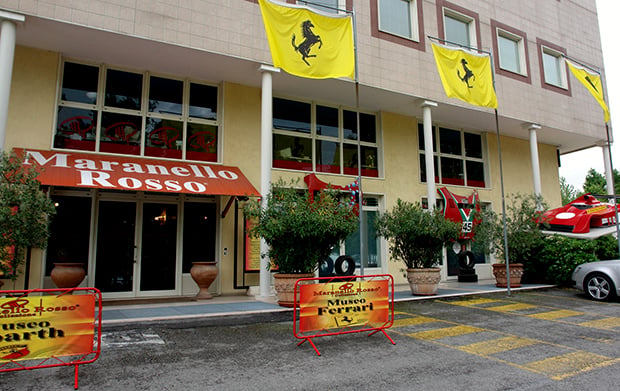
The collection is dedicated to Italian Ferrari cars and racing constructions created by Carlo Abarth, consisting of two museum sites. The first presents 250 samples of Italy’s best cars, one of which belonged to Marilyn Monroe, and introduces the production stages and technological evolution. The second hall contains 40 serial examples of Scorpion sports and racing cars from Abarth and is devoted to the designer’s biography. An exclusive offer from the Ferrari museum is the option to order a test drive.
Address: Strada dei Censiti, 21. Opening hours: 10:00-13:00 and 14:00-18:00, Saturday and Sunday by appointment. Admission fee: 12 euros to the Ferrari museum and 12 euros to the Abarth museum.
Museum of Curiosities
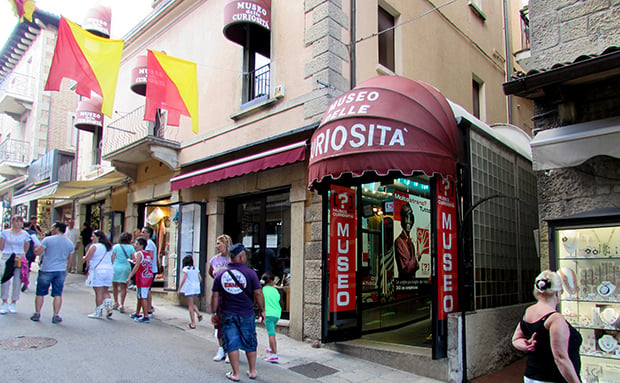
This museum is famous for its vast collection of unusual items brought from different places on the planet and belonging to different time periods. The museum exhibits will interest both adults and children. In the themed halls, you can see real-life stories of people whose existence is almost impossible to believe if it weren’t confirmed by the Guinness Book of Records. Here, you can see the world’s fattest and tallest representatives of the human race, compare your wasp waist with a model girl and a dwarf woman, and admire ancient fashion hairstyles. The zoological sector introduces a giant crab and an ancient bird’s egg, 80 cm high.
Address: Salita alla Rocca, 26. Admission fee: adults — 7 euros, children — 4 euros. Opening hours: daily from 10:00 to 6 pm, except July and August: from 9 am to 8 pm (opening hours may vary depending on the season).
We recommend the following hotels in San Marino:
- Hotel Rossi San Marino, 10 minutes drive from Serravalle
- Hotel Rosa San Marino, Hotel Rosa with a view of the Guaita tower
- Hotel Cesare San Marino, 20 meters from the public parking lot on Cava Antica square

